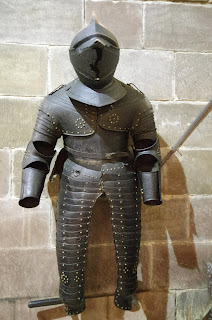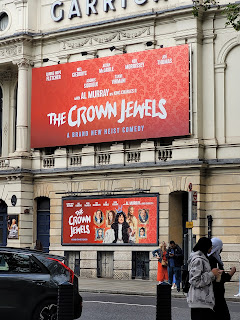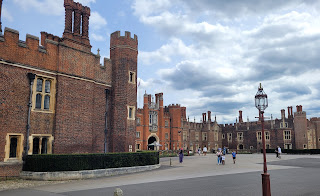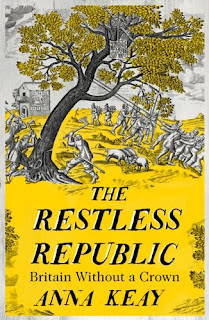Houses of Interest: Cheshire
The County of my birth, and just a few miles away from Château KeepYourPowderDry, so why has it taken so long to get around to writing an entry?
The Legh's were staunch Royalists, although didn't really have much to do with the soldiering due to a series of unfortunate events. Peter Legh XI inherited the property from his father just before the outbreak of war. He was elected MP for Newton in 1640, but died from his injuries sustained in a duel in 1642. His son, Frances inherited the Hall but died without issue in 1643. Frances's nephew inherited the hall. Richard was a minor during the Civil War but was elected as an MP during the Commonwealth. His support of the Royalists led him to become Lord Lieutenant of Cheshire during the Restoration.
What's there now?
Lyme really is spectacular on a sunny day, the National Trust and it's army of volunteers do a magnificent job at keeping the estate in pristine condition.
The Stag Room houses a number of portraits of Charles I and Charles II. The Charles I chairs are also on display here.
Interestingly, the story of the Charles chair(s) appears to have changed. One of the set of four chairs used to be displayed so you could see the black cloth underneath the seat - this was described as being part of the cloak worn by Charles on the day of his execution. It was used underneath the chair as, for obvious reasons, it couldn't be on open display. Nowadays the story presented is very different: the seats of all four chairs were upholstered with the lining of Charles's cloak. Which is true?
There are a number of interesting portraits on display other than those in the Stag Room.
Lyme is home to the 'Lyme Missal' deemed the most important book in the NT's collection. It is also home to some of Grinling Gibbons's finest work, although the room that they are in has a multimedia display about the Missal in it which distracts, somewhat, from the stunning carvings.
Please note Lyme can be incredibly busy on sunny weekends and school holidays, check the NT website for the Park and Ride options.
Not exactly a 'house of interest', but outside Duckinfield Town Hall (which was part of Cheshire during the Civil Wars, now a Metropolitan Borough of Manchester), there is a statue of Lieutenant Colonel Robert Duckinfield. Robert defended Stockport from Prince Rupert, besieged Wythenshawe, and captured the Isle of Man. He also helped put down Booth's rebellion.
Beeston was seized by Sir William Brereton in early1643; the defences shored up, and the site garrisoned. The castle would not last the year under Parliamentarian control as in December the castle surrendered to a small force led by Captain Thomas Sandford.
Local legend has it that Sandford and eight of his men famously scaled the cliffs at night to take the Castle; but there doesn't appear to be any evidence for this taking place. Thomas did persuade the Castle's Governor to surrender of that we can be sure, the events that led up to this appear slightly different to the oft repeated tale. There are a number of accounts that refer to Sandford and his men gaining entry to the Castle via a 'byway' and capturing the garrison's arsenal. If the night time cliff scaling had taken place one would expect Mercurius Aulicus to feature such a dramatic tale in its reporting of the Castle falling to the King's men - alas it does not.
The castle governor would be executed for failing to hold the castle; the now Royalist castle was besieged from November 1644 until November 1645, they were eventually starved into surrender . The castle would be sleighted in 1646.
What’s there now?
Cared for by English Heritage, there is a small visitor centre with a museum, gift shop and café. There are few information panels on the site: the castle is presented in its ruined state.
Peover Hall and St Lawrence's Church both featured briefly in Rupert's March North: Part One. Peover Hall is a private residence, but can be visited during the summer months. Guided tours are available: sadly photography is not allowed inside the property, and it might be best to take the commentary from the guides with a generous pinch of salt.
 |
| Sir Philip Mainwairing's cuirassier armour, St Lawrence's Church, Peover |
Lyme Hall has already been briefly mentioned in the first part of Rupert's March North. A National Trust property (so expect lots of Colin Firth memorabilia, travel blankets and expensive boiled sweets for sale in the shop). Let's get Colin Firth out of the way first: yes, Lyme was the location for that lake scene in the BBC Pride and Prejudice. Surprised there isn't a statue of Colin emerging from the lake...
The Legh's were staunch Royalists, although didn't really have much to do with the soldiering due to a series of unfortunate events. Peter Legh XI inherited the property from his father just before the outbreak of war. He was elected MP for Newton in 1640, but died from his injuries sustained in a duel in 1642. His son, Frances inherited the Hall but died without issue in 1643. Frances's nephew inherited the hall. Richard was a minor during the Civil War but was elected as an MP during the Commonwealth. His support of the Royalists led him to become Lord Lieutenant of Cheshire during the Restoration.
Thomas Legh, Richard's brother
What's there now?
Lyme really is spectacular on a sunny day, the National Trust and it's army of volunteers do a magnificent job at keeping the estate in pristine condition.
Arty picture, well, just because
Whilst untouched during the fighting, there are a number of portraits and artefacts pertinent to the wars.
The Stag Room houses a number of portraits of Charles I and Charles II. The Charles I chairs are also on display here.
Two of the Charles chairs
Interestingly, the story of the Charles chair(s) appears to have changed. One of the set of four chairs used to be displayed so you could see the black cloth underneath the seat - this was described as being part of the cloak worn by Charles on the day of his execution. It was used underneath the chair as, for obvious reasons, it couldn't be on open display. Nowadays the story presented is very different: the seats of all four chairs were upholstered with the lining of Charles's cloak. Which is true?
 |
| Charles I |
 |
| James Stuart, Duke of Richmond and part of the stag frieze |
 |
| One of two Charles II portraits on display in the Stag Room |
 |
| The Earl of Strafford, known as 'Black Tom Tyrant' for his treatment of the Irish |
 |
| Sir Henry Gage, breaker of the siege of Basing House, briefly Governor of Oxford |
Lyme is home to the 'Lyme Missal' deemed the most important book in the NT's collection. It is also home to some of Grinling Gibbons's finest work, although the room that they are in has a multimedia display about the Missal in it which distracts, somewhat, from the stunning carvings.
Please note Lyme can be incredibly busy on sunny weekends and school holidays, check the NT website for the Park and Ride options.
Not exactly a 'house of interest', but outside Duckinfield Town Hall (which was part of Cheshire during the Civil Wars, now a Metropolitan Borough of Manchester), there is a statue of Lieutenant Colonel Robert Duckinfield. Robert defended Stockport from Prince Rupert, besieged Wythenshawe, and captured the Isle of Man. He also helped put down Booth's rebellion.
Tabley House in Knutsford was built in the 1760s and now is run as a nursing home. So why does it feature in the ECW Travelogue? Tabley House houses the the Tabley House Collection, amongst the art treasures on display is William Dobson's portrait of Lord Byron, which features the wound he received on New Years Day 1643 at Burford, when he was struck on his left cheek by a halberd.
Congleton has a number of places of interest: firstly Congleton Museum in the Market Square has two important Civil War era coin hoards.
 |
The first, and largest hoard is known as the Walker Hoard. Actually this was four separate hoards but potentially are related as they share some similarities. In total there are 3400 coins dating from Edward VI to Charles II, and are believed to have been buried in 1675.
.JPG) |
The smaller hoard consists of 18 coins found embedded in the wall of a timber frame house on Moody Street - these coins bear the heads of James I and Charles I.
.JPG) |
Congleton has a number of old timber framed buildings: one, has a connection to the regicide John Bradshaw. The White Lion is believed to have been the offices where Bradshaw served his articles as a trainee.
John Bradshaw lived in Congleton, his house has long since been demolished, the Georgian house that now stands on the site bears a plaque.
St Helen's Church in Tarporley, located just off the High Street has several pieces of armour found in the fields close by. There was skirmish close by, the armour possibly being discarded after this fight. There is a close helmet, two pikemen's pots, and a pair of breastplates.
Beeston Castle was built in the early C13th as part of the defensive chain that protected England along the Welsh Marches. Perched atop Beeston Tor, you can see why the ‘Royal Castle planning department’ picked the location: the site gives a clear view over the Cheshire Plain, away to Snowdonia, and also the Fylde Coast. The site is not wheelchair friendly, and has some considerable inclines and uneven ground.
 |
 |
Cared for by English Heritage, there is a small visitor centre with a museum, gift shop and café. There are few information panels on the site: the castle is presented in its ruined state.
Gawsworth Hall was the home of Sir Edward Fitton; who raised a Regiment of Foot for the King; he was involved in the Storming of Bristol; and would be given command of the Bristol garrison in July 1642. He died suddenly of consumption and is buried in St James The Great, Gawsworth. The Hall would then pass into the ownership of Sir Charles Gerrard.
 |
| Sir Edward, and his wife Anne |
Peover Hall and St Lawrence's Church both featured briefly in Rupert's March North: Part One. Peover Hall is a private residence, but can be visited during the summer months. Guided tours are available: sadly photography is not allowed inside the property, and it might be best to take the commentary from the guides with a generous pinch of salt.
If following a SatNav to get to Peover, please note many struggle to find the entrance to the estate - Google Maps works!
 |
| Peover Hall |
Peover was the home of the Mainwairing family for a thousand years and towards the end of the family's tenure, the house fell on hard times, much of its contents were sold off, the house eventually changing hands in the early twentieth century.
Bought by the Brooks family at the outbreak of the second world war, it was requisitioned for the war effort and became Patton's headquarters. Sadly, the Americans didn't look after the place very well and the damage caused to the Georgian wing of the house helped hasten its demolition in the 1960s.
Henry Brooks attended many country house sales buying furniture and artefacts in keeping with the style of Tudor Peover. For which he, and his family (who have continued this act of restoration) should be applauded.
The Great Hall is decorated with what is described as mostly mid seventeenth century arms and armour. Some of it is, having been removed from St Lawrence's for display in the Hall. Unfortunately the vast majority of armour on display is Napoleonic, with a few bits of Victorian replicas thrown into the mix. One of the Duke of Wellington's boots is proudly displayed - it is possibly the best item in the room, unfortunately it wasn't Wellington's. It appears to be a seventeenth century bucket top boot, and is absolutely fabulous.
The Oak Bedroom has a fine portrait of Catherine of Braganza, Charles II's queen. There is a beautiful Tudor bed in the room, which is festooned with heraldry from Henry VIII's coat of arms, which sadly causes the guide's script no end of problems.
The State Bedroom features a number of portraits of Charles I and his family members.
A very fine copy of Strafford and his secretary (Sir Philip Mainwairing) from the school of Van Dyck hangs in what is called the Officers' Mess. This copy of the painting has long been associated with Peover and was returned to the house by the Brooks family.
Architecturally the highlight of Peover are the Carolian Stables.
St Lawrence's Church houses the Mainwaring family chapel. On display is Sir Philip Mainwaring's cuirassier armour, a breast plate, a lobster pot helmet and a morion.
Macclesfield was for the King. There are a number of Tudor and early C17th buildings tucked away in the town centre, most notably the Bate Hall public house (don't be put off by the C19th frontage) which claims to have a number of ghosts. Macclesfield castle was garrisoned; long since gone, the last remaining tower was demolished in the 1930s. The location of the castle was, until very recently, the site of Marks and Spencers on Mill Street.
 |
| Macclesfield Castle, well the site of it at least |
Adlington Hall was garrisoned by Thomas Legh for the King. The house fell to Parliament twice, in 1642 and again in February 1644 after sustained bombardment by Sir Thomas Fairfax.
Adlington was used as a wedding venue, opening to the general public for visits on Sundays during the summer months. The Georgian frontage hides a Tudor timber frame frontage at the rear. The Hall was recently sold, and public access is not currently available.
 |
| Crewe Hall |
Crewe Hall is a Jacobean mansion that now operates as a hotel, spa, and wedding venue. The hall was garrisoned by Parliament in early 1643, before being taken by Lord Byron in December 1643. The events were described by Edward Burghall of Beeston
The royalists laid siege to Crewe Hall, where they within the house slew sixty, and wounded many, on St. John's Day; but wanting victuals and ammunition, they were forced to yield it up the next day, and themselves, a hundred and thirty-six, became prisoners, stout and valiant soldiers, having quarter for life granted them
Providence Improved
General Fairfax would retake the house shortly after his victory at Nantwich.
 |
| Cholmondley Castle |
Cholmondley Castle was garrisoned by both Parliament and the King throughout the Wars. It was never besieged, garrisons arriving and departing as fortunes arose. The castle is a private residence, but the gardens are open to visitors throughout the year.
Doddington Hall in Nantwich was a Parliamentarian garrison that was taken by Royalists in January 1644. Their stay didn't last long as Fairfax retook the house in May 1644. The Hall was demolished and a new house built upon the site in the mid C18th. This house was abandoned and slowly returning to nature, thankfully the builders have started work to secure the property's future.
Christleton Old Hall was part of Chester's outer defences, but was taken by Parliament prior to the siege of Chester. The Hall has been converted into private apartments.
Eaton Hall was garrisoned for the King, its governor was Sir Richard Grosvenor. The Hall held a strategic position commanding the Crook of Dee and the Eccleston ferry crossing. It would fall to parliament in 1645. The hall was demolished in the early C19th and a grand house built. the Hall is the private residence of the Duke of Westminster and not open to the public.
Duddon was the site of the Headless Woman public house that was demolished in 2013 and new housing built upon the site. The pub dated from the C16th and owes its name to a local legend concerning a Parliamentarian raiding party. The raiding party visited Hockenhull Hall but found that the family had fled and hidden their valuables. Only Grace Twigg, the housekeeper, remained. The soldiers questioned her about the hiding place of the valuables, and when she refused to tell, they beheaded her, carrying her body and head to the pub for disposal. Legend says that her ghost walks along the bridle path between Hockenhull and the site of the pub. Naturally she carries her head under one arm.
 |
| Halton Castle |
Halton Castle was garrisoned by the Royalists under the command of Captain Walter Primrose. The castle would be besieged by Sir William Brereton in 1643, the garrison surrendering after a few weeks. Parliament's garrison would later abandon the castle, and the Royalists moved back in, the garrison commanded by Colonel Fenwick. Parliament would return to the castle after Marston Moor turning their big guns on the garrison, who quickly surrendered, after the castle sustained significant damage. In 1646 the castle was ordered to be sleighted.
The castle ruins are managed by Norton Priory, who open the castle to the public for special events throughout the year. The grounds around the castle are open year round and free to visit.
Dodleston Old Hall was a moated manor house that stood on Kinnerton Road, Dodleston. Taken by Sir William Brerton in autumn 1645 and used as his winter headquarters.
The Hall is long since gone, a late C18th farmhouse standing close to the site. The remains of the moat are scheduled, and are visible from the road.
Tarvin was garrisoned for Parliament, the village having earthwork defences encircling it. There were a number of minor skirmishes in the area.
 |
| Henry Hardware's memorial, with musket ball damage |
St Andrew's Church, bears the scars of musket fire on its walls. Inside the church is a memorial plaque to alderman Henry Hardware who died in March 1583. The plaque too bears a scar from a musket ball.
For more Cheshire related Civil War sites see also:
All of the Cheshire points of interest are marked below (with the exception of Rowton Heath and Chester)
Postcodes for SatNavs
Lyme Park SK12 2NR
Duckinfield Town Hall SK16 4LA
Bradshaw House, Congleton CW12 1RU
Lyme Park SK12 2NR
Duckinfield Town Hall SK16 4LA
Tabley House, Knutsford WA16 0HB
Congleton Museum CW12 1ET
White Lion, Congleton CW12 1BDBradshaw House, Congleton CW12 1RU
St Helen's Church, Tarporley CW6 0AG
Beeston Castle, Tarporley CW6 9TX
Gawsworth Hall SK11 9RN
St James The Great, Gawsworth SK11 9RJ
Peover Hall, Peover WA16 9HW
Bate Hall, Macclesfield SK11 6BX
Mill Street, Macclesfield SK11 6NE
Adlington Hall, Mill Lane, Adlington SK10 4LF
Crewe Hall, Weston Rd, Haslington CW1 6UZ
Cholmondley Castle, Malpas SY14 8ET
Doddington Hall, London Rd, Nantwich CW5 7NJ
Christleton Old Hall, Pepper Street, Christleton, CH3 7AB
Eaton Hall, Chester CH4 9JE
Headless Woman pub (site of), Duddon Mews, Tarporley Road, Duddon CW6 0EW
Halton Castle, Castle Rd, Halton, Runcorn WA7 2BE
Dodleston Hall Kinnerton Road, Dodleston CH4 9LP
St Andrew's Church, Church St, Tarvin CH3 8EB
If you enjoyed reading this, or any of the other posts, please consider supporting the blog.
Thanks.






.JPG)



























Very interesting - some great portraits there.
ReplyDeleteReally think I need to seek out some Parliamentarian supporting households to maintain 'balance'.
Delete